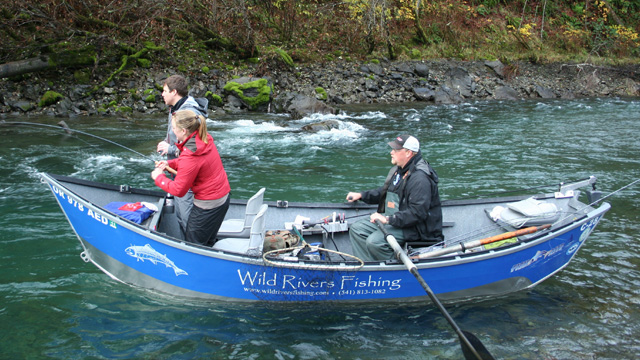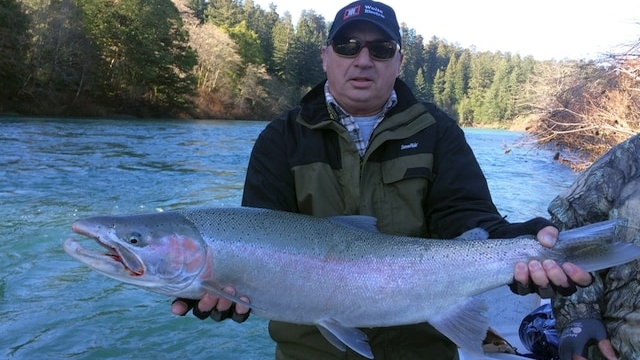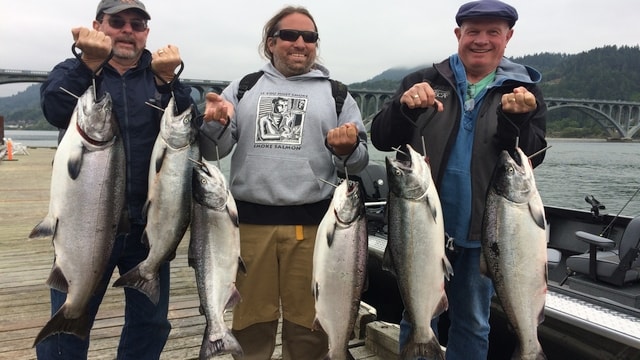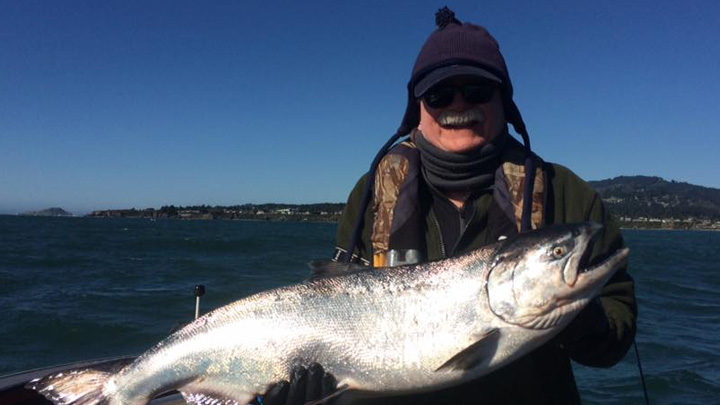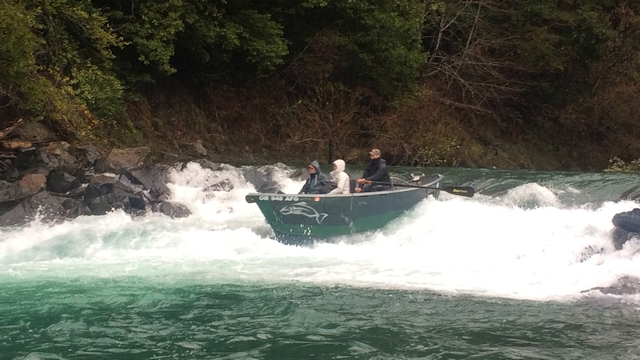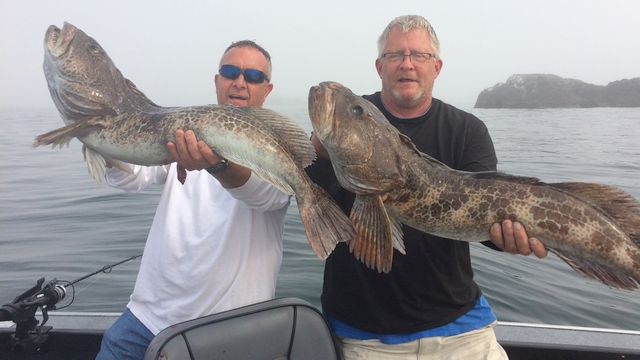Going Rogue for Springers
Get in on the action and catch chinook on Oregon's Upper Rogue River.
This article appeared in the May 2010 issue of Washington-Oregon Game & Fish

For years, the upper section of Oregon’s Rogue River was the Northwest’s signature spring Chinook fishery. It was here, near the small town of Shady Cove, where the popular spring and summer season spawned not only some of the best small-stream salmon fishing anywhere, but is also where the aluminum drift boat and the ever-effective back-bouncing technique originated.
Feisty king salmon, fat as a football, stack up in the scenic section of river below Lost Creek Lake in the late spring and summer. From the bank or in drift boats, anglers catch the hard-fighting, great-eating salmon from the cool, clear waters of the Rogue.
This year, after a string of less-than-fabulous springer seasons on the Rogue, the stage is set for a comeback for this unique, fabled fishery. In the Upper Rogue, where the river winds through forested hills with classic salmon water of pools behind big boulders with lots of riffles and small rock gardens, anglers fish for holding salmon, which arrive April through July and then wait until early fall to spawn. Anglers often enjoy a good bite each day as hatchery fish stack up below the fish ladder, and when fish counts are high, drift boaters are treated to small stream salmon fishing at its best.
On the mend
In recent years, the Rogue’s spring Chinook season has fallen upon hard times. But coming off some of the lowest fish runs on record, spring salmon anglers have good reason to be optimistic this year. Ocean conditions have improved, pressure from commercial fishing has eased, a major dam has been removed from the Rogue, and the number of fish returning to the upper river appears to be on an upswing.
“The last several years we’ve had some pretty low returns due to poor ocean conditions. Last year was slightly improved and this year should be a little better,” says David Haight, a biologist for the Oregon Department of Fish and Wildlife in Medford.
Longtime Rogue guides and anglers point to several factors in predicting a solid turnaround for the famed up-river fishery. For the pas two years, commercial salmon fishing has been shut down off the Northern California coast. Rogue spring salmon are south-migrating fish, meaning the troll fleet that in years past has caught half a million salmon each summer has been tied to the docks since 2007. The result has been a record return to Northern California’s Smith River, solid returns to the Chetco and Klamath rivers, and a good fall salmon return to the Rogue last year. Anglers are hopeful the trend continues with a steady increase in Rogue spring salmon numbers this year and in the near future.
During the middle part of the last decade, ocean conditions were poor. Baby salmon entered saltwater with little to no food. The result was poor salmon runs coastwide. Now, with ocean conditions on the mend, biologists have already seen a rebound in Southern Oregon salmon runs.
The upper section of the Rogue, between Lost Creek and Gold Ray dams, is poised for a rebound.
During its peak in the early 1990s, as many as 80,000 fish a year returned over Gold Ray Dam. The 10-year average for the Upper Rogue springer run is 26,000 fish.
The run hit is low point in 2007, with only 11,171 springers counted at Gold Ray Dam. In 2008, nearly 13,000 springers were counted. Last year, upwards of 14,000 came back. The upward trend is expected to continue this year, and the future looks bright.
Aside from better conditions in the ocean, leading to higher survival, the Oregon Department of Fish and Wildlife has completed a new management plan for Rogue River spring salmon. More hatchery fish may be released. New goals have been set for habitat improvement. And what has been called the biggest fish killer on the Rogue, Savage Rapids Dam, was removed in late 2009. ODFW estimates the dam killed 10 to 20 percent of the out migrating salmon run each year, and also made it difficult for returning adult salmon.
Run timing
The first spring Chinook of the season usually enter the lower river in mid- to late March. Lower river fishermen - still-fishing between Agness and Gold Beach - enjoy the best fishing in April and early May. But it’s not until the first week of May until springers arrive in good numbers 150 miles upstream between Shady Cove and Lost Creek Dam.
“Usually about the first part of May there are enough springers to fish for,” says John Billows, the owner of Pat’s Hand Tied Flies, a busy tackle shop beside Highway 62 on the Upper Rogue. “Last year it was good from the first of May through the 10th of June.”
The first spring salmon are typically caught by late-season steelhead anglers side-drifting roe near Shady Cove. Sometime in late April or early May someone will hook a fish that is way too much for the 8-pound leader and 10-pound mainline. The word of the first springer will quickly spread, and anglers will begin to flock to fishing deadline near the hatchery each morning, tossing Corkies and roe in hopes of catching what many consider the best-tasting fish in the Northwest.
Gearing up
Medium-heavy gear is the standard on the Upper Rogue. Most anglers use 8 ½-foot rods combined with level-wind reels capable of holding 20-pound-test mono. Like all springers, the Rogue’s first run of salmon are powerful fish, fat as footballs as they will be living off their body fat for up to six months.
To slow down hard-fighting fish, a quality rod is needed. Many anglers use a strong yet sensitive rod, such as Wright & McGill’s Alaska Medium Drifter.
More than half of the total springer catch each season is hauled in by bank anglers. The typical Upper Rogue bank fishing rig is a 4- to 6-foot leader with a 2/0 hook like an Eagle Claw octopus fished with a medium-size Corky. Rocket red, green/chartreuse and watermelon are favorite colors, although glow-in-the-dark Corkies are the best bet at first light. Most bank anglers fish without roe, although some use yarn soaked in scents like Patuzke Nectar or Liquid Krill.
Bank sinkers are the weight of choice for shore-bound anglers. A good selection of weights ranging from half an ounce to three ounces are needed depending on the hole. With lots of snags in the Upper Rogue, many anglers will tie loops with 10-pound monofilament line to their sinkers, making it easier for them to break away if snagged.
Drift boaters will back-bounce roe early in the season and switch to plugs like T50 FlatFish or Mag Lips in July. Chrome with a chartreuse bill is the go-to plug for springers.
Most back-bouncers fish roe without a Corky or Spin-N-Glo in the Upper Rogue, using a nickel to quarter-size cluster. Some will use a red or orange Puff Ball to help float their bait just off the bottom. Roe cured in Pautzke’s Fire Cure is among the most popular bait on the Upper Rogue.
Some of the best success out of boats on the Upper Rogue is enjoyed by visiting anglers who bring live sand shrimp with them. Fresh sand shrimp are difficult to find in the Rogue Valley.
“Most people just use roe,” Billows says. “If you can get it, use sand shrimp with a big ole ball of roe with it. If you rig sand shrimp and fish it with a cluster of eggs, that would be your best bet.”
Sardine wraps are a good addition to FlatFish or Kwikfish in the Upper Rogue. Many guides will fillet the sardines ahead of time, add a little borax, and marinate with Liquid Krill or sardine oil. Anise is another good scent for springers.
Hot spots
For bank anglers, the Hatchery Hole, Casey State Park and Slide Hole are the most popular spots. All are located beside Highway 62.
Hatchery springers bolt straight to the pools below the hatchery after crossing Gold Ray Dam and anglers have the best access to them fishing at the upper holes.
“If it’s a hatchery fish they are booking right up to the hatchery,” Billows says. “From when the fish cross Gold Ray Dam to the hatchery is about 60 hours. They are pretty much coming right up the river.”
After the first big rain in late April or late May, there is usually a good bite at the hatchery, where anglers fish from the rip-rap below the fish ladder or will wade out in front of the boat ramp.
There also is good bank access at Tou Velle State Park and the city water tower on the opposite side.
Early in the season, drift boaters will either slowly work the water between Casey State Park and Rogue Elk Park, sometimes making two drifts, or fish from Casey down to Shady Cove.
In June and July, when more wild fish show up, the stretch below Shady Cove can be good. There are takes outs at Takelma and Dodge Bridge, as well as Tou Velle State Park. Rattlesnake Rapids is between Tou Velle and Dodge and is the most technical rapid on the Upper Rogue.
For anglers unfamiliar with the Upper Rogue, the best drift is from Casey or the hatchery to Rogue Elk.
“Usually during the spring season, the water flow is up,” Billows says. “It’s not too technical going from the hatchery to Shady Cove.”
There are two spots anglers need to be aware of, however. “On the first island, go to the left, and on the second island, go to the right,” Billows says. “That’s what I tell everybody.”
The first island is located a couple hundred yards downstream from the Casey State Park boat ramp. At first glance it appears the best path is straight through, on the right, but there are a lot of boulders in the shallow tailout. Instead, follow Billows’ advice and go left to save your boat from a few dents.
Shuttles can be arranged at Pat’s Hand Tied Flies (541-878-2338), where fresh roe and tackle is also available, as well as snacks and sodas.
To help give spring salmon fishing a boost, the hatchery will “recycle” fish throughout the season. Once hatchery fish arrive at the hatchery, they are trucked back to Tou Velle State Park and released for another run upriver.
Salmon fly hatch
Many Upper Rogue anglers plan their springer trip to coincide with the annual salmon fly hatch, with produces exceptional fly fishing for big native rainbows.
“It happens sometime around the first part of June,” Billows says. “The first of June would be a good time to come. The hatch itself will last about a week, maybe even as long as 10 days.”
The best fishing is right when the hatch begins, as trout carelessly grab everything floating down the river as they gorge themselves. By the time the hatch tapers off, most of the fish are fat and lazy and don’t bite as well.
“You need to be here during the first two or three days of the hatch,” Billows says. “Those big trout get so stuffed that they can’t eat anymore even though the presentation is right there.”
Trout fishing not only good in the Upper Rogue during the hatch, but also in nearby Lost Creek Lake, where nearly 80,000 legal-size rainbows are stocked each year. During the hatch, 100-trout days are achievable for fly anglers, who enjoy savage strikes.
Pat’s Hand Tied Flies has a large selection of salmon fly patterns for the Upper Rogue.
Upper Rogue lore
Drift boats have been used for nearly a century on Northwest rivers, but it was the upper Rogue’s springer fishery that led to the creation of the welded aluminum drift boat. Willie Illingworth, an Upper Rogue guide, was tired of the wear and tear associated with wood drift boats, so he asked longtime boat builder Glenn Wooldridge to make him an aluminum drifter. Wooldridge declines and told Willie he’d have to build his own. Willie did, and soon Alumaweld Boats was in business. After Willie’s partners bought him out, Willie Boats emerged several years later. Today, Willie Boats, Fish-Rite, Alumaweld and Pavati drift boats are all manufactured just a few miles from the Upper Rogue.
The Rogue headwaters was also where back-bouncing roe originated.
Guide Arnold Gosnell accidently discovered the technique in the 1930s. Back then, anglers would catch the salmon by casing into deeper pools with salmon. One of Gosnell’s clients lowered his bait to the bottom and slowly worked the roe into the pool using a series of motions with the rod to “bounce” the bait into the hole. Gosnell realized what was happening and used the deadly technique for years before other anglers caught on. Now back-bouncing is used with high success throughout the Northwest and Alaska, but it was guides from the Upper Rogue who slowly brought the technique elsewhere when they branched out and fished other rivers.
